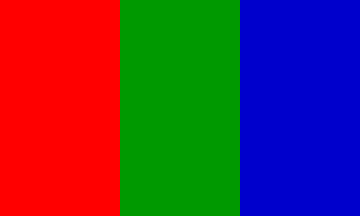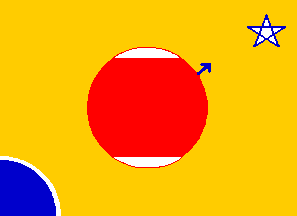![[Flag of Mars (front)]](../images/q/qp-4_or.gif)
image by António Martins-Tuválkin, 17 Jun 2024
![[Flag of Mars (back)]](../images/q/qp-4_or_.gif)
image by António Martins-Tuválkin, 17 Jun 2024

Last modified: 2025-08-02 by tomislav todorovic
Keywords: mars | mars society | terraforming | proposal | lee (pascal) | orelove (michael) | paine (thomas o.) | the mars flag |
Links: FOTW homepage |
search |
disclaimer and copyright |
write us |
mirrors
There is certainly no shortage of Mars flags now. I remember a Mars
Society group once devised an informal vote on 50 or so proposed
flags. (Not related at all to the red-green-blue-flag.)
But who knows when this need will develop?
Richard Knipel, 14 Jun 2004
Mediaeval alchemists were right linking
the planet Mars and the metal iron: Mars derives its red color from
iron oxide, basically rust, which also colors blood red, giving it the
name of the war god.
Richard Knipel, 19 Jun 2004
The Mars symbol is basically a shield and
spear (Mars/Ares was the god of war).
Albert Kirsch, 19 Jul 2004
Almost all Mars’ Flags I have seen have the
symbol, indeed the most remarkable aspect of
the design of the Mars Society flag is that it does not
include it.
Richard Knipel, 19 Jun 2004
A Mars symbol on a flag these days would
be ambiguous, given that biologists use it for "male", though I suppose
sufficient exposure could change public perception of that. (These days
one might even associate it with gay rights or
something.)
Albert Kirsch, 19 Jul 2004
 image by António Martins, 17 Jul 2004
image by António Martins, 17 Jul 2004
The Mars Society already makes plenty of good use out of its flag.
Richard Knipel, 14 Jun 2004
Red stands for the current desert, green for a 2nd step planet with
vegetation and blue for the fully terraformed blue planet Mars.
Jorge Candeias, 11 Apr 2001
The designer, Pascal Lee, perhaps wanted to avoid the ambiguity of the
♂ symbol, not wanting to alienate women, and perhaps also wanted a
more “serious”, conservative-looking design.
Richard Knipel, 19 Jun 2004
The Mars Society sponsored flag of Mars seems to be in dark shades of green and blue, and its ratio seems to be 3:5, judging from these photos (slow server!), taken in early 2004 at the Mars Desert Research Station in Utah, USA:
The Mars Flag flies from atop the Flashline Mars Arctic Research
Station in Devon Island, Nunavut, Canada, the Mars Desert Research
Station in Utah, USA, and will soon fly from stations in Iceland and
Australia. These are analog Mars research stations, investigating
Earth-like environments with some similarities to Mars.
Richard Knipel, 18 Jul 2004
The research station is supposed to simulate “Mars on Earth”,
like an embassy represents one country’s territory inside another.
Dean McGee, 12 Jul 2002
The Purpose of the Mars Society is to further the goal of the
exploration and settlement of the Red Planet.
Richard Knipel, 18 Jul 2004
The flag was half-staffed at the Utah station for the
Columbia tragedy, as seen on the
Mars Society
website.
Richard Knipel, 17 Jul 2004
During its mission to the Hubble Space Telescope, the
Space Shuttle Discovery carried a Martian
flag into orbit for the first time. It was a red, green and blue tricolor,
with the vertical red segment closest to the mast, followed by the green,
and then the blue. Its form was originally suggested to Mars Society
president Robert Zubrin by Mars Arctic Research Station task force leader
Pascal Lee during their summer 1999 site selection expedition to Devon
Island. The red, green and blue colors derive from stages of Mars’
transformation from barrenness to life depicted in the epic
Red Mars,
Green Mars, Blue Mars trilogy by Kim Stanley Robinson. Red,
green and blue are also the primary components of the spectrum, symbolizing
unity in diversity, as well as light itself, and thus reason and
enlightenment. The tricolor form also traditionally represents the
republican values of liberty, equality and justice. The flag was sewn by
Maggie Zubrin and brought aboard at the invitation of astronaut John Mace
Grunsfeld. (Astronauts are allowed to manifest several items of special
importance on Space Shuttle flights of an official nature.)
Jim Burk, 06 Jan 2000,
quoting from the
Mars Society
website
Charmed by the flag’s undulations, I can imagine my overwrought
meditation transcending its worries about the how, the when, and
transforming into a much more visceral sort of euphoria, a happy glow
tinted with the colors with which Mr. Robinson chose to paint the
future.
Richard Knipel, 17 Jul 2004,
quoting from the
Mars Society
website
 image by Richard Knipel, 20 Jul 2004
image by Richard Knipel, 20 Jul 2004
This page
has some information about a different Mars Flag given to recipients
of the Thomas O. Paine Award for the Advancement of Human Exploration
of Mars, given by another space advocacy group, the Planetary Society,
presented to the Mars Pathfinder and Mars Global Surveyor teams in 1998.
(Larger image here.)
The symbolism is pretty clear: Mars points the way from Earth toward
the stars.
Richard Knipel, 18 Jul 2004
The recipient is awarded a memorial plaque and the prestigious Mars
flag designed by Mr. Paine.
Richard Knipel, 18 Jul 2004,
quoting from the
NASA
website
The "circle + arrow pointing to the upper right" is the
astronomical symbol for Mars.
Marc Pasquin, 18 Jul 2004
 image by António Martins, 14 Jun 2004
image by António Martins, 14 Jun 2004
At this
website, Bergen County Technical High School, Teterboro, US-NJ, plays
voyage to Mars simulation. Included among other important requirements, a
community flag for the habitat dwellers. On this on line
photo
(top left), it is shown in all of its splendour: Red ~2:5 flag with a
row of 12 black 5-pointed stars pointing outwards at the bottom and top,
black triangles blocking the hoist and fly edges, edged in the inside
sides irregularly in yellow each with a column of four red 5-pointed
stars; on the main red area, the lettering "THE MARS FLAG" in yellow
capitals set in a descending text line.
António Martins, 14 Jun 2004
Front (obverse)![[Flag of Mars (front)]](../images/q/qp-4_or.gif) image by António Martins-Tuválkin, 17 Jun 2024 |
|
Back (reverse)![[Flag of Mars (back)]](../images/q/qp-4_or_.gif) image by António Martins-Tuválkin, 17 Jun 2024 |
In
this article, Michael Orelove, a member of NAVA and the Mars Society, details his proposal for a flag of Mars.
Paul Bassinson, 31 Jul 2016
This was published in the 66th issue of The Universe in the Classroom,
Summer 2004, by the Astronomical Society of the Pacific (San Francisco,
US-CA), pages 22-28. [oov04]
This article offers an overview of several proposals for a flag of Mars
and the author’s critique thereof, and presents his own proposal:
Michael Orelove’s Mars flag is 1:2 with black background with a yellow
half sundisc filling the hoist and a smaller red disc, symbolizing Mars.
Thin golden lines representing the orbital paths of the inner planets
are shown, symmetrically on the upper and lower halves of the flag,
respectively behind and in front of the discs (something thatís flipped
on the reverse). On the upper hoist a single thin golden line stands for
the orbit of Jupiter.
The geometry of all these elements is shown on a 24◊48 grid diagram on
page 27 of [oov04]. The radius of
the Mars disc is 4/24ths of the height (=1/6th) and its placed off the hoist
3/4th of the flagís width, with the apices of the orbit lines of the inner planets
placed at scale (at 4.59, 8.55, 11.87, 18.00, and 61.66, respectively, 1/24ths
off the hoist) and all between the vertical lines of half and one quarter flag
widths off the hoist. This divides the flag vertically in four parts, from the hoist:
the sun, the inner planets, Mars, and Jupiter.
On page 24 of [oov04], a photo shows
the creator and three other people (who?) holding a cloth version of this flag,
but with significant detail differences: The orbit lines are not at scale and curve
at the apex, the one for Mars doesnít overlap the disc on its lower half, and the
overall ratio is noticeably less oblong than 1:2.
António Martins-Tuválkin, 29 Mar 2024
[According to the source photo,] the flag width was made greater than the diameter
of the Sun disc, which is why the ratio is less oblong than it should have been.
Considering the author’s drawings of the flag obverse and reverse, which can be found
on pages 25 and 27 of [oov04], the orbit lines for Mars
are not meant to overlap the red disc at all (it would make sense that they overlap, though).
[This was respected while making the photographed flag.]
Also note that the reverse is not just the mirror-image of the obverse - it is
created from the obverse in two steps:
1) Flip horizontally the image of the obverse.
2) Flip vertically everything except the orbit of Jupiter.
(This would work whether the orbit line overlaps the Mars disc or not.)
Tomislav Todorovic, 29 Mar 2024